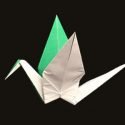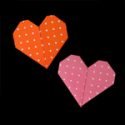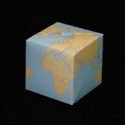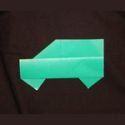Noshi
According to Complete Origami (Eric Kenneway), attaching noshi to gifts has been a Japanese custom since the 12th century. He suggests that the earlier forms of noshi may have been fresh meats or fish but, with time, noshi evolved to include dried fish (specifically, stretched and dried abalone).
This is somewhat consistent with the information from Noshi: Classic Japanese Origami (Isao Honda), which states that “noshi” is an abbreviation of “noshi awabi” which literally means “stretched abalone”.
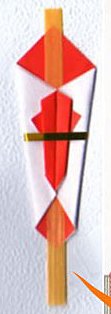
Currently, the term “noshi” refers to the folded paper which is attached to a gift as a sign of good fortune; the meaning and presence of the meat/fish is all but forgotten.

How to Fold Noshi
In the past, noshi was folded with two rectangular sheets of hosho (thick, handmade paper). The sheets (one red and one white) were placed one-over-the-other to achieve double-sided color.
In modern times, noshi is folded from a rectangular or a square sheet of paper. It can be two overlapping sheets of paper (one red, one white) or it can be one sheet of double sided origami paper (red and white). A fairly new invention is noshigami. There are even more modern iterations on the concept: there is wrapping paper with the image of noshi printed directly on the paper itself. The gift is wrapped so that the image of the noshi is on the top-right side of the package.
Below are instructions on how to fold noshi. Please be aware that the method of folding was not acquired from those who are familiar with the age-old art of folding noshi. Indeed, most Japanese people buy pre-made noshi the same way an American may buy a pre-made gift bow from a department store. Click on the image for instructions.
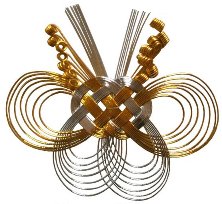
-
Books with Easy Origami
- Easy Origami: over 30 simple projects by John Montroll
- Origami Fun Kit for Beginners by John Montroll
- My First Origami Kit by Joel Stern
- Easy Origami: A Step-by-Step Guide for Kids by C Alexander & M Meinking
- Fun With Easy Origami (Dover Origami Papercraft)
- Origami: A Step-by-Step Introduction to the Art of Paper Folding by T Cook & S Henry
- Easy Origami For Kids Book Traditional Japanese Folding Papers Overs 20 Projects by J Wish
- Easy Origami for Kids: Over 40 Simple Origami Projects by O Brooks
Please Help
Please help by reporting broken links so that we can fix them. One easy message from you can save us hours and hours of clicking. Thanks!
-
More Origami Diagrams and Instructions…
-
These free origami instructions are made available to you by the paper folding community at large. If you have a diagram you would like to share, or if your diagram is listed here and you wish to have it removed, please Contact Us. Diagrams are intended for personal use. Copyright of the models lie with the origami creators and designers. Please contact the designer and/or creator directly for non-private usage of a model and/or artwork.









